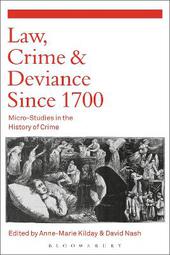
|
Law, Crime and Deviance since 1700: Micro-Studies in the History of Crime
Hardback
Main Details
| Title |
Law, Crime and Deviance since 1700: Micro-Studies in the History of Crime
|
| Authors and Contributors |
Edited by Professor David Nash
|
|
Edited by Anne-Marie Kilday
|
| Physical Properties |
| Format:Hardback | | Pages:344 | | Dimensions(mm): Height 234,Width 156 |
|
| ISBN/Barcode |
9781472585271
|
| Classifications | Dewey:364.903 |
|---|
| Audience | | Undergraduate | | Postgraduate, Research & Scholarly | |
|---|
|
Publishing Details |
| Publisher |
Bloomsbury Publishing PLC
|
| Imprint |
Bloomsbury Academic
|
| Publication Date |
17 November 2016 |
| Publication Country |
United Kingdom
|
Description
CHOICE Outstanding Academic Title 2017 Law, Crime and Deviance since 1700 explores the potential for the 'micro-study' approach to the history of crime and legal history. A selection of in-depth narrative micro-studies are featured to illustrate specific issues associated with the theme of crime and the law in historical context. The methodology used unpacks the wider historiographical and contextual issues related to each thematic area and facilitates discussion of the wider implications for the history of crime and social relations. The case studies in the volume cover a range of incidents relating to crime, law and deviant behaviour since 1700, from policing vice in Victorian London to chain gang narratives from the southern United States. The book concludes by demonstrating how these narratives can be brought together to produce a more nuanced history of the area and suggests avenues for future research and study.
Author Biography
David Nash is Professor of History at Oxford Brookes University, UK. He is editor of the journal Social and Cultural History and author of several books, including Christian Ideals in British Society: Stories of Belief in the Twentieth Century (2013) and Blasphemy in the Christian World (2007). Anne-Marie Kilday is Professor of Criminal History at Oxford Brookes University, UK. She is author of A History of Infanticide in Britain (2013), co-author of Cultures of Shame: Exploring Crime and Morality in Britain 1600-1900 (2010) and editor (with David Nash) of Histories of Crime, 1600-2000 (2010).
ReviewsOne of the most impressive aspects of the collection is the clarity with which each author explains their own approach to microhistory and its value and contribution to broader historical debates. The methodological explanations and cohesive approach offered throughout is especially valuable, as the reader understands why this approach matters and what it adds to the topic analysed and to wider issues relating to the history of crime. * History Today * The book ... underlines the importance of the micro-historical approach to the history of crime and justice ... One appreciates ... reading this collective work of interesting contributions. * Lectures (Bloomsbury Translation) * This is a broad, colorful collection of 13 narratives of crime and criminals and how their microhistories (case studies) illuminated the larger issues in criminal justice systems in Britain (mostly), the US, and Europe. This is history from below, but it is not statistical and is mercifully free of postmodern obscurities. Each case is fascinating. The various contributors cover such subjects as an acid attack by a jilted woman in the 1870s and her acquittal, thus illuminating gender considerations; the confinement of a supposed prostitute in a Victorian lock hospital; the disputed use in London in the 1840s of plainclothes policemen in pubs to nab Sunday drinkers; a murderous crime spree by an American deserter and his English girlfriend in wartime Britain; and Victorian white-collar crime, a subject scarcely understood then and often ignored by modern historians. There are also microhistories of convicts, including chain gang narratives from the southern US and transportees to Australia. Much of the detail in these narratives depends on the remarkable ability of historians today to use online primary sources to bring to life the forgotten. The book is scholarly and clearly written, extensively documented, and fascinating. Summing Up: Highly recommended. All academic levels/libraries. * CHOICE * Highlighting a diverse cast of characters - criminals, cops, clergy among others - this collection of essays about individuals and their relation to the criminal justice system in Britain, Europe and the United States provides a "bottom up" view of crime, police, and prisons. These microhistory case studies add an important dimension to generalized theories or statistics that describe structure and aggregate patterns of crime and criminal justice rather than unique experiences. In addition to specialists, students will find themselves engaged with the personal narratives that bring the past to life. * Wilbur R. Miller, Stony Brook University, USA *
|